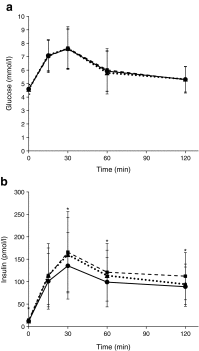The impact of maternal gestational weight gain on cardiometabolic risk factors in children
- PMID: 30225524
- PMCID: PMC6223878
- DOI: 10.1007/s00125-018-4724-x
The impact of maternal gestational weight gain on cardiometabolic risk factors in children
Abstract
Aims/hypothesis: Accumulating evidence suggests an impact of gestational weight gain (GWG) on pregnancy outcomes; however, data on cardiometabolic risk factors later in life have not been comprehensively studied. This study aimed to evaluate the relationship between GWG and cardiometabolic risk in offspring aged 7 years.
Methods: We included a total of 905 mother-child pairs who enrolled in the follow-up visit of the multicentre Hyperglycemia and Adverse Pregnancy Outcome study, at the Hong Kong Centre. Women were classified as having gained weight below, within or exceeding the 2009 Institute of Medicine (IOM) guidelines. A standardised GWG according to pre-pregnancy BMI categories was calculated to explore for any quadratic relationship.
Results: Independent of pre-pregnancy BMI, gestational hyperglycaemia and other confounders, women who gained more weight than the IOM recommendations had offspring with a larger body size and increased odds of adiposity, hypertension and insulin resistance (range of p values of all the traits: 4.6 × 10-9 < p < 0.0390) than women who were within the recommended range of weight gain during pregnancy. Meanwhile, women who gained less weight than outlined in the recommendations had offspring with increased risks of hypertension and insulin resistance, compared with those who gained weight within the recommended range (7.9 × 10-3 < p < 0.0477). Quadratic relationships for diastolic blood pressure, AUC for insulin, pancreatic beta cell function and insulin sensitivity index were confirmed in the analysis of standardised GWG (1.4 × 10-3 < pquadratic < 0.0282). Further adjustment for current BMI noticeably attenuated the observed associations.
Conclusions/interpretation: Both excessive and inadequate GWG have independent and significant impacts on childhood adiposity, hypertension and insulin resistance. Our findings support the notion that adverse intrauterine exposures are associated with persistent cardiometabolic risk in the offspring.
Keywords: Adiposity; Cardiometabolic risk factors; Chinese children; Gestational weight gain; Hypertension; Insulin resistance; Maternal pre-pregnancy BMI.
Conflict of interest statement
The authors declare that there is no duality of interest associated with this manuscript.
Figures

Comment in
-
Gestational weight gain: an ounce of prevention is still worth a pound of cure.Diabetologia. 2018 Dec;61(12):2507-2511. doi: 10.1007/s00125-018-4749-1. Epub 2018 Oct 15. Diabetologia. 2018. PMID: 30324490 Free PMC article. No abstract available.
Similar articles
-
Joint and Independent Associations of Gestational Weight Gain and Pre-Pregnancy Body Mass Index with Outcomes of Pregnancy in Chinese Women: A Retrospective Cohort Study.PLoS One. 2015 Aug 27;10(8):e0136850. doi: 10.1371/journal.pone.0136850. eCollection 2015. PLoS One. 2015. PMID: 26313941 Free PMC article.
-
A retrospective study of gestational weight gain in relation to the Institute of Medicine's recommendations by maternal body mass index in rural Pennsylvania from 2006 to 2015.BMC Pregnancy Childbirth. 2018 Jun 18;18(1):239. doi: 10.1186/s12884-018-1883-1. BMC Pregnancy Childbirth. 2018. PMID: 29914428 Free PMC article.
-
Association of maternal body mass index and gestational weight gain rate with cardiometabolic traits in childhood: A prospective cohort study.Nutr Metab Cardiovasc Dis. 2025 Feb;35(2):103699. doi: 10.1016/j.numecd.2024.07.016. Epub 2024 Jul 25. Nutr Metab Cardiovasc Dis. 2025. PMID: 39168803
-
The association of maternal gestational weight gain with cardiometabolic risk factors in offspring: a systematic review and meta-analysis.Nutr Rev. 2025 Feb 1;83(2):e106-e115. doi: 10.1093/nutrit/nuae027. Nutr Rev. 2025. PMID: 38607346
-
Association between gestational weight gain and perinatal outcomes among twin gestations based on the 2009 Institute of Medicine (IOM) guidelines: a systematic review.J Matern Fetal Neonatal Med. 2022 Dec;35(25):6527-6541. doi: 10.1080/14767058.2021.1918083. Epub 2021 May 27. J Matern Fetal Neonatal Med. 2022. PMID: 34044741
Cited by
-
The Epidemiology and Mechanisms of Lifetime Cardiopulmonary Morbidities Associated With Pre-Pregnancy Obesity and Excessive Gestational Weight Gain.Front Cardiovasc Med. 2022 Mar 22;9:844905. doi: 10.3389/fcvm.2022.844905. eCollection 2022. Front Cardiovasc Med. 2022. PMID: 35391836 Free PMC article. Review.
-
Experiences regarding nutrition and exercise among women during early postpartum: a qualitative grounded theory study.BMC Pregnancy Childbirth. 2019 Oct 21;19(1):368. doi: 10.1186/s12884-019-2508-z. BMC Pregnancy Childbirth. 2019. PMID: 31638920 Free PMC article. Clinical Trial.
-
The role of midwives and obstetrical nurses in the promotion of healthy lifestyle during pregnancy.Ther Adv Reprod Health. 2021 Aug 6;15:26334941211031866. doi: 10.1177/26334941211031866. eCollection 2021 Jan-Dec. Ther Adv Reprod Health. 2021. PMID: 34396131 Free PMC article. Review.
-
Contributions of subjective status to eating behaviors, obesity, and metabolic health across development.Appetite. 2025 Jan 1;204:107735. doi: 10.1016/j.appet.2024.107735. Epub 2024 Oct 30. Appetite. 2025. PMID: 39481682 Review.
-
Per- and polyfluoroalkyl substance mixtures and gestational weight gain among mothers in the Health Outcomes and Measures of the Environment study.Int J Hyg Environ Health. 2021 Jan;231:113660. doi: 10.1016/j.ijheh.2020.113660. Epub 2020 Nov 9. Int J Hyg Environ Health. 2021. PMID: 33181449 Free PMC article.
References
Publication types
MeSH terms
Grants and funding
LinkOut - more resources
Full Text Sources
Other Literature Sources
Medical
Molecular Biology Databases

